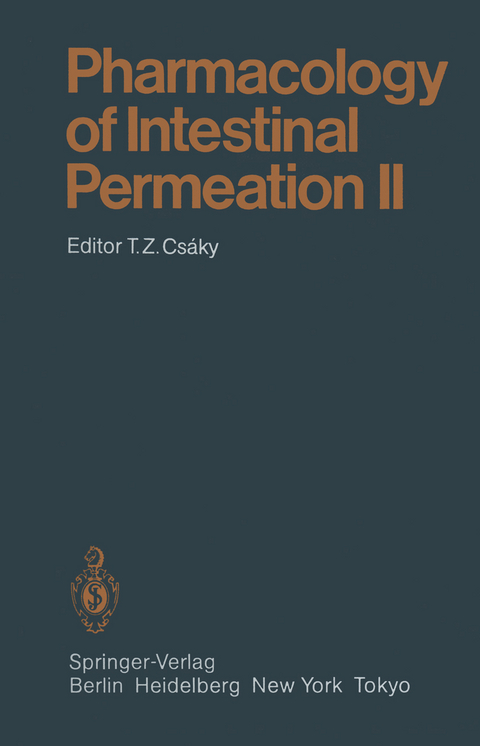
Pharmacology of Intestinal Permeation II
Springer Berlin (Verlag)
978-3-642-69510-0 (ISBN)
18 Intestinal Absorption of Xenobiotics..- A. Introduction.- B. Drug Absorption and Pharmacologic Response.- C. The Side of Drug Absorption.- D. The Intestinal Barrier and its Permeability.- E. Factors Which Influence the Intestinal Absorption of Xenobiotics.- References.- 19 Role of Digestive Enzymes in the Permeability of the Enterocyte.- A. Introduction.- B. Relationship Between the Hydrolytic and Transport Systems of the Enterocytes.- C. Enzyme Apparatus of the Apical Membrane of the Enterocytes.- D. Characterization of the Transport of Free Monomers and Hydrolysis-Released Monomers.- E. The Enzyme Transport Complexes of the Apical Membrane of the Enterocytes.- F. Conclusion.- References.- 20 The Surface pH of the Intestinal Mucosa and its Significance in the Permeability of Organic Anions..- A. Introduction.- B. Intestinal pH Measurements.- C. Acidification Studies.- D. The Intestinal Acid Microclimate.- E. Alternative Concepts.- F. Absorption and the Microclimate Hypothesis: Three Paradigms.- G. Modelling the System.- H. Conclusion.- References.- 21 The Role of the Unstirred Water Layer in Intestinal Permeation.- A. Unstirred Water Layers: Historical and Conceptual Background.- B. Water Compartments In and Around the Intestinal Mucosal Cell.- C. Comparison of Dimensions of the Unstirred Water Layer with Morphological Parameters.- D. The Glycocalyx and Mucus as Diffusion Barriers.- E. Intestinal Membrane Structure.- F. Movement of Solutes Across Biologic Membranes: General Principles.- G. Effects of Aqueous Diffusion Barriers on Solute Movement.- H. A Consideration of Surface Areas.- J. Consequences of Failure to Correct for the Unstirred Water Layer and Passive Permeation.- K. Diffusion Barriers of Greater Complexity.- L. Possible Functional Heterogeneity of the Villus.- M. Effect of Carrier Molecules, Solubility of Probe, and Metabolism in the Cytosolic Compartment.- N. Effect of Membrane Polarity on Penetration of Passively Transported Molecules.- O. Anomalous Behavior of Diffusion of Certain Solutes Across the Intestine.- P. Methods Available for the Measurement of the Dimensions of the Unstirred Water Layer.- Q. Examples of the Effect of Unstirred Water Layers on Intestinal Transport.- References.- 22 Intestinal Permeation of Organic Bases and Quaternary Ammonium Compounds.- A. Introduction.- B. Absorption of Organic Bases and Quaternary Ammonium Compounds.- C. Intestinal Secretion of Organic Cations.- D. A Concept for the Intestinal Permeation of Organic Cations.- E. Comparative Aspects of Organic Cation Secretion.- F. Conclusions.- References.- 23 Role of Blood Flow in Intestinal Permeation.- A. Introduction.- B. Methods.- C. Theoretical Considerations.- D. Experimental Data.- E. Concluding Remarks.- References.- 24 Hormonal Effects on Intestinal Permeability.- A. Introduction.- B. Gastrin.- C. Cholecystokinin.- D. Vasoactive Intestinal Polypeptide.- E. Secretin.- F. Insulin.- G. Glucagon.- H. Other Gastrointestinal Polypeptides.- J. General Remarks on the Effects of Gastrointestinal Hormones on Intestinal Permeation.- References.- 25 The Influence of Opiates on Intestinal Transport.- A. Introduction.- B. In Vivo Studies.- C. In Vitro Studies.- D. Ion Flux Responses.- E. Antisecretory Activity.- F. Summary.- References.- 26 Effect of Cholera Enterotoxin on Intestinal Permeability.- A. Introduction.- B. Cholera Enterotoxin-Intestinal Interaction.- C. Role of Increased Filtration in the Production of Cholera-Induced Intestinal Secretion.- D. Conclusion.- References.- 27 Aspects of Bacterial Enterotoxins Other than Cholera onIntestinal Permeability.- A. Introduction.- B. Escherichia coli.- C. Shigella.- D. Prostaglandin Released from Inflamed Tissue and Fluid and Electrolyte Secretion.- E. Salmonella.- F. Pseudomonas aeruginosa.- G. Campylobacter fetus.- H. Yersinia enterocolitica.- J. Noncoliform Enterobacteriaceae.- K. Food Poisoning Organisms.- L. Staphylococcus.- M. Additional Mechanisms for Toxin-Mediated Permeation Defects.- References.- 28 Mechanisms of Action of Laxative Drugs.- A. Introduction.- B. Intestinal Tract Smooth Muscle Response to Laxatives.- C. Effects of Laxatives on Fluid and Electrolyte Movement.- D. Bulk and Dietary Fibers.- E. Summary.- References.- 29 Action Mechanisms of Secretagogue Drugs.- A. Introduction.- B. Theoretical Considerations.- C. Triarylmethane and Anthraquinone Derivatives.- D. Surfactants.- E. General Summary and Concluding Remarks.- References.- 30 Use and Abuse of Cathartics.- A. Introduction.- B. Classification.- C. Indications for Use.- D. Laxative Abuse.- E. Summary.- References.- 31 Intestinal Permeability Studies in Humans.- A. Introduction.- B. Methods for Studying Intestinal Permeability in Humans.- C. Permeability Characteristics of the Human Gut.- D. Influence of Drugs on Intestinal Permeability.- E. Intestinal Permeability in Disease.- References.
| Erscheint lt. Verlag | 19.11.2011 |
|---|---|
| Reihe/Serie | Handbook of Experimental Pharmacology |
| Co-Autor | J.G. Banwell |
| Zusatzinfo | XVIII, 590 p. |
| Verlagsort | Berlin |
| Sprache | englisch |
| Maße | 170 x 242 mm |
| Gewicht | 1037 g |
| Themenwelt | Medizin / Pharmazie ► Medizinische Fachgebiete ► Pharmakologie / Pharmakotherapie |
| Medizin / Pharmazie ► Pharmazie ► PTA / PKA | |
| Schlagworte | Kinetics • Permeation • Pharmacokinetics • pharmacology • Research |
| ISBN-10 | 3-642-69510-8 / 3642695108 |
| ISBN-13 | 978-3-642-69510-0 / 9783642695100 |
| Zustand | Neuware |
| Haben Sie eine Frage zum Produkt? |
aus dem Bereich


